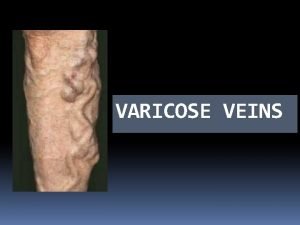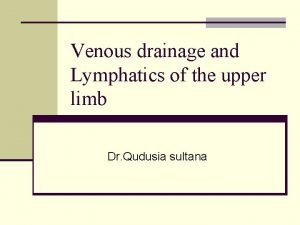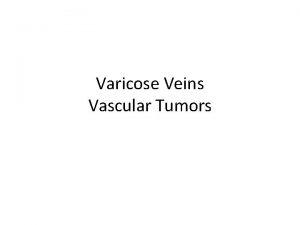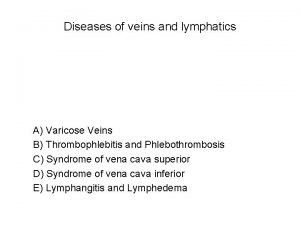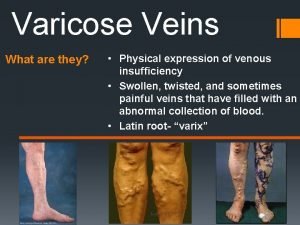Veins and lymphatics VEINS AND LYMPHATICS Varicose Veins










- Slides: 10

Veins and lymphatics

VEINS AND LYMPHATICS - - Varicose Veins are abnormally dilated, tortuous veins produced by prolonged increase in intraluminal pressure and loss of vessel wall support. The superficial veins of the leg are typically involved venous pressures in these sites can be markedly elevated venous stasis and pedal edema (simple orthostatic edema). Some 10% to 20% of adult males and 25% to 33% of adult females develop lower extremity varicose veins

RISK FACTORS obesity Female gender pregnancy. familial tendency (premature varicosities results from imperfect venous wall development) Morphology - wall thinning intimal fibrosis in adjacent segments spotty medial calcifications (phlebosclerosis) Focal intraluminal thrombosis venous valve deformities (rolling and shortening)

COMPLICATIONS stasis, congestion, edema, pain, and thrombosis chronic varicose ulcers embolism is very rare.

THROMBOPHLEBITIS AND PHLEBOTHROMBOSIS The deep leg veins account for more than 90% of cases (DVT) the most important clinical predispositions are: congestive heart failure, neoplasia, pregnancy, obesity, the postoperative state, and prolonged bed rest or immobilization local manifestations: distal edema, cyanosis, superficial vein dilation, heat, tenderness, redness, swelling, and pain migratory thrombophlebitis (Trousseau sign): hypercoagulability occurs as a paraneoplastic syndrome related to tumor elaboration of procoagulant factors

THE SUPERIOR VENA CAVAL SYNDROME - - caused by neoplasms that compress or invade the superior vena cava. A characteristic clinical complex including marked dilation of the veins of the head, neck, and arms with cyanosis.

THE INFERIOR VENA CAVAL SYNDROME can be caused by neoplasms that compress or invade the inferior vena cava (IVC)- particularly hepatocellular carcinoma and renal cell carcinoma, which show a striking tendency to grow within veins induces marked lower extremity edema, distention of the superficial collateral veins of the lower abdomen, and-with renal vein involvement-massive proteinuria.

LYMPHANGITIS AND LYMPHEDEMA - - - Lymphangitis is the acute inflammation due to bacterial infections spread into the lymphatics most common are group A β-hemolytic streptococci. lymphatics are dilated and filled with an exudate of neutrophils and monocytes. red, painful subcutaneous streaks (the inflamed lymphatics), with painful enlargement of the draining lymph nodes (acute lymphadenitis). subsequent passage into the venous circulation can result in bacteremia or sepsis.

PRIMARY LYMPHEDEMA can occur as: 1 - A congenital defect, resulting from lymphatic agenesis or hypoplasia. 2 - Secondary or obstructive lymphedema - blockage of a previously normal lymphatic; e. g. Malignant tumors - Surgical procedures that remove lymph nodes - Postirradiation - Fibrosis - Filariasis - Postinflammatory thrombosis and scarring

CHYLOUS Milky accumulations of lymph in various body cavities caused by rupture of dilated lymphatics, typically obstructed secondary to an infiltrating tumor mass - chylous ascites (abdomen) - Chylothorax (chest) - Chylopericardium (pericardium)
